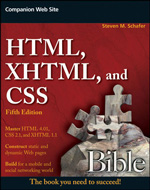
HTML, XHTML, and CSS Bible, Fifth Edition
by Steven M. Schafer
Wiley Publishing, Inc.
www.wiley.com
US $39.99, CAN $47.99
ISBN: 978-0-470-52396-4
744 pages
I have a confession to make—I love reference books. I love to read novels, too, but there’s something about reference books that makes me happy. It’s a wonderful feeling knowing that if I have a question about, say, an unfamiliar knitting technique, I can walk over to the bookshelf, grab one of my knitting books, look up the technique, then put the book back on the shelf, where it will be waiting for me next time I need it.
HTML, XHTML, and CSS Bible, by Steven M. Schafer is just such a book.
As it says on the cover of the book, “The book you need to succeed!” and I agree. The HTML, XHTML, and CSS Bible is a well-organized, comprehensive tome covering pretty much everything you would need to know about coding and styling a web site. The table of contents alone is 25 pages!
The book is divided into four sections:
Part I—Creating Content with HTML
Part II—HTML Tools and Variants
Part III—Controlling Presentation with CSS
Part IV—Additional CSS Tools
Part I discusses the basic elements of HTML, including tags, lists, tables, and images. Schafer’s liberal use of diagrams and screenshots helps the reader better understand the ideas presented.
In Part II, the author introduces readers to various text editors, web design products, and image programs, as well as information about publishing a web site, and validating documents. Also in this section are some tips and tricks relevant to page design and loading pages faster. Did you know there are ways of protecting your email address from robots and spammers? Have you wondered about using JavaScript on your web site? Read all about it in Part II.
The meat and potatoes of the book is Part III—CSS. HTML is what places text and images on the page. CSS is what styles the page, and gives a web site a unique personality. Schafer talks about basic CSS concepts, including text formatting, padding, margins, borders, color, and fonts. But unlike many other HTML/CSS books, he dives deeper into CSS by covering more advanced features for power designers, and those who just want to learn more. Want to know what Pseudo-Elements are? See Chapter 26. How about Inheritance? Chapter 28 will explain it all. To me, CSS is the fun part of coding, but can be a little overwhelming. Part III of the HTML, XHTML, and CSS Bible breaks down CSS into small, bite-size pieces to make it a little less intimidating.
Part IV may be the section of the book readers use the most. The bulk of the section contains five quick reference guides covering XHTML Elements, HTML Special Characters, CSS 2.1 Properties, CSS 2.1 Selectors, and Pseudo-Elements and Pseudo-Classes. Say you can’t remember how to make a copyright symbol. Turn to the HTML Special Characters appendix, and look for the sub-section Copyright, Trademark, and Registered Entities. You’ll find two ways of creating the symbol—either “©” if you want the Decimal Entity, or the Mnemonic Entity, “©”. (The quotation marks are not part of the code.) All the appendices are quite thorough, and show examples where appropriate.
Schafer goes into great detail explaining concepts in simple terms. I’ve always had a problem understanding the difference between padding and margins; now I feel more comfortable using these styles in my web designing.
Depending on your prior knowledge, if any, of HTML and CSS, the HTML, XHTML, and CSS Bible can be read sequentially, or used more as a reference when you need the answer to a specific question. Notes, cross-references, and tips are scattered throughout each chapter. More experienced readers will benefit from the discussion of some advanced topics, such as HTML 5, CSS 3, scripts, and mobile documents, for example.
Schafer states in the introduction that this is not a web design book, and it’s definitely not. Because of that, I don’t think this book is appropriate for someone with no HTML experience or knowledge. Before a reader can apply the concepts of HTML/CSS, he needs to have a good understanding of basic web design, how one HTML element works with another. There are plenty of books that give a good overview of web design; at least one should be read before reading the HTML, XHTML, and CSS Bible. I think the reader will get much more out of the book this way.
I graduated college recently with my associates degree in web design. Only three classes were required in HTML/CSS/Javascript. HTML, XHTML, and CSS Bible picks up where my college education left off, and is now part of my web design/coding library. Anyone with an interest in HTML/CSS will benefit from this book.
email – MyMac Magazine – Twitter – Advertise – Reviews Archive – Podcast

Leave a Reply
You must be logged in to post a comment.